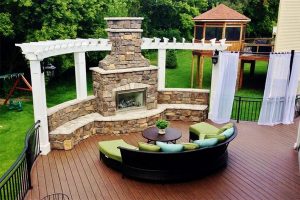
Each year when the weather turns warm the thoughts of many homeowners turn to all things outdoors. There are beautiful plants to maintain, pools to enjoy, lawns that need to be manicured, and outdoor sports to watch and compete in. Then there is one of the most pleasurable outdoor pursuits- cooking. With so many fresh fruits and vegetables in season and so many wonderful recipes to try out it is one of the best things about summer. Just as homeowners want the best in landscaping, pools, and lawn furniture to show off, they also want the best in outdoor cooking spaces to enjoy summer’s bounty.
1. Climate drives the choice of outdoor materials.
The first consideration when designing your dream outdoor cooking space must always be the climate that you live in. It is the driving force behind many of the elements in your design. First, it must dictate the materials you choose for your cooking space. Given the cost and the effort involved in installing the wood and brick that typically provides the foundation of an outdoor cooking area, it is extremely important to choose materials and designs that will stand up to the climate you live in. This is true whether you are living in a climate with harsh winters and hot summers, like New England, or a climate with long months heat and humidity, like the southern states or a climate with dry, arid heat, such as the desert southwest.
2. Let the natural space dictate design.
Look around at the natural beauty of your surroundings. Any outdoor cooking space should reflect and enhance the natural surroundings. When making choices about the materials used, the furniture and appliances, and decorative accents you should consider how they work with the natural surroundings. The good thing about designing an outdoor cooking space as opposed to an indoor kitchen is that you already have a backdrop for your design. Nature provides you with a palette of colors and a design motif to work with. You get to use that when you dream up your perfect outdoor looking space.
3. Use the light.
When you have an outdoor area for cooking and eating you have planned for variations in light and temperature. There are a variety of options when it comes to lighting. You should look at where you are creating natural spots for both cooking and gathering to eat when choosing the placement of light sources. The type of lighting you choose should work with the over design. The same is true of shade. You can choose from many different attractive ways to create shade for cooking and eating. For variations in temperature, there are a variety of fans that can circulate the air. Attractive fire pits and large grills create warmth in cooler weather.
4. Go small.
When you are designing an outdoor cooking space you should plan for the amount of food you will be storing and cooking. You will find that you might not need full-sized appliances. Smaller appliances such as mini-fridges can work for you. Since you most likely will only need to store and cook enough food for one meal smaller appliances can be a good solution. They are less expensive and take up less space, leaving more money and space for the more decorative aspects of your outdoor cooking space!
5. Go big- but not too big.
It is easy to get caught up in the excitement of designing your own personal outdoor cooking space. You want it to have all the impressive gadgets and for the furniture and appliances to have all the latest features. Let your imagination run free but then consider reigning it in a bit. If you take a moment to step back and analyze your lifestyle and the cooking you will be doing outside you might find that there are some gadgets and features you don’t really need. You don’t have to shell out money and make room for something you probably aren’t even going to use. Be deliberate in what you choose to include in your outdoor cooking space.
6. Just add water.
One of the most important features you should consider adding to your outdoor cooking space is a good sink. While the plumbing involved might be a little tricky it can be totally worth it to have a sink outside. Having a sink makes both food prep and clean-up easier and faster. It also makes it easy for people to wash their hands before eating. Think about including a sink in your plans.
7. The devil is in the details.
Time to get real. There is, after all, a difference between looking at pictures of perfectly manicured outdoor eating spaces with pristine furniture and the latest appliances and making it happen in your own backyard. To begin with, start with a design and a budget that is right for you. Don’t rush that first step. Then you should carefully vet any contractors you use. Make sure they are reliable and have a reputation for quality work. Before you begin any work check in at town hall and make sure you are following town regulations and ordinances and that you have any permits you need. Following those steps will make the process smoother and give you the outdoor cooking space of your dreams!
